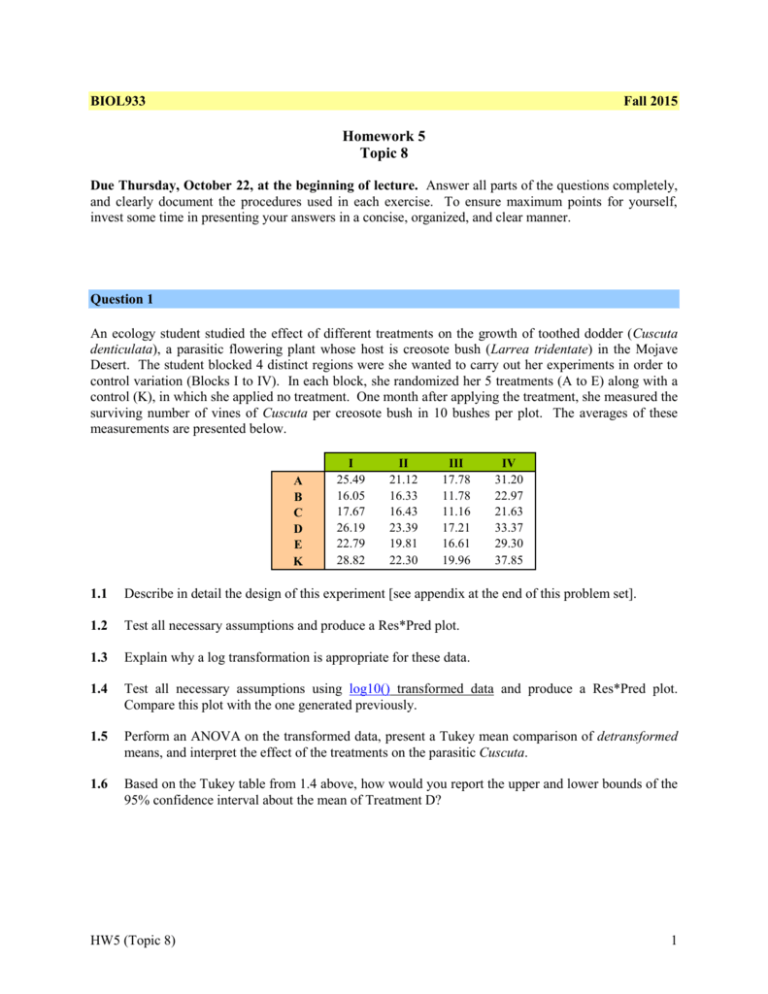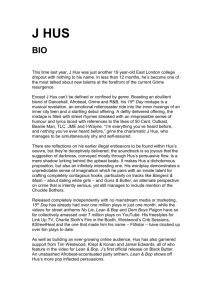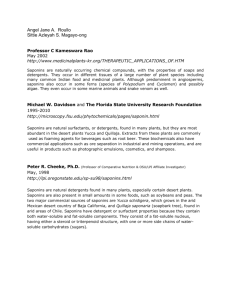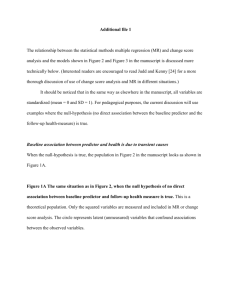Word
advertisement

BIOL933 Fall 2015 Homework 5 Topic 8 Due Thursday, October 22, at the beginning of lecture. Answer all parts of the questions completely, and clearly document the procedures used in each exercise. To ensure maximum points for yourself, invest some time in presenting your answers in a concise, organized, and clear manner. Question 1 An ecology student studied the effect of different treatments on the growth of toothed dodder (Cuscuta denticulata), a parasitic flowering plant whose host is creosote bush (Larrea tridentate) in the Mojave Desert. The student blocked 4 distinct regions were she wanted to carry out her experiments in order to control variation (Blocks I to IV). In each block, she randomized her 5 treatments (A to E) along with a control (K), in which she applied no treatment. One month after applying the treatment, she measured the surviving number of vines of Cuscuta per creosote bush in 10 bushes per plot. The averages of these measurements are presented below. A B C D E K I 25.49 16.05 17.67 26.19 22.79 28.82 II 21.12 16.33 16.43 23.39 19.81 22.30 III 17.78 11.78 11.16 17.21 16.61 19.96 IV 31.20 22.97 21.63 33.37 29.30 37.85 1.1 Describe in detail the design of this experiment [see appendix at the end of this problem set]. 1.2 Test all necessary assumptions and produce a Res*Pred plot. 1.3 Explain why a log transformation is appropriate for these data. 1.4 Test all necessary assumptions using log10() transformed data and produce a Res*Pred plot. Compare this plot with the one generated previously. 1.5 Perform an ANOVA on the transformed data, present a Tukey mean comparison of detransformed means, and interpret the effect of the treatments on the parasitic Cuscuta. 1.6 Based on the Tukey table from 1.4 above, how would you report the upper and lower bounds of the 95% confidence interval about the mean of Treatment D? HW5 (Topic 8) 1 Question 2 Saponins are natural tensoactives (surfactants) derived from the tree Quillaja saponaria, indigenous to Chile. They have been used for over 100 years in the production of photographic films, as foaming agents in food and beverages, and as adjuvants in animal vaccines, cosmetics, etc. A researcher is interested in studying the effect of two solvents (A and B) on the extraction of saponins from the bark of Quillay. Four different extraction processes were tested: Method A used only solvent A, Method B used only solvent B, Method C combined both solvents A and B, and Method D used no solvents. The extractions were done in four different facilities (1 - 4) throughout the central valley of Chile. Eight trees were sent to each facility and there they randomized the 8 tress into the 4 extraction methods. The % w/w of saponins to total water soluble compounds is presented below: Method A B C D Facility 1 30.2 35.2 26.0 22.8 33.0 35.6 16.4 17.2 Facility 2 38.5 35.2 31.8 34.2 47.7 38.1 19.3 19.5 Facility 3 35.2 39.7 35.4 34.1 50.9 43.4 26.2 24.4 Facility 4 40.9 49.5 31.7 31.0 54.4 56.0 24.6 23.0 [Little tidbit for the interested: Quillaja saponaria in grown today as a crop, and it is illegal to use the bark from naturally growing trees for their saponin.] 2.1 Describe in detail the design of this experiment [see appendix at the end of this problem set]. 2.2 Test all necessary assumptions using the full exploratory model (i.e. a model that contains the Block*Treatment interaction) and produce a Res*Pred plot. 2.3 Transform the data with the most appropriate power transformation, present new assumption test values, and produce a new Res*Pred plot. Compare this plot with the one generated previously. 2.4 Using the transformed data, again retain the Block*Treatment interaction term in your model and answer the following questions. Choose the most sensitive method of analysis that controls MEER for all questions, taken as a group. [Tip: Be sure to use the right error term (MSBlock*Trtmt!] a. b. c. d. 2.5 Is there a significant treatment effect? Is there a significant effect of Solvent A on saponin yield? Is there a significant effect of Solvent B on saponin yield? Is the effect of Solvent A different at the different levels of Solvent B? Present a graph with the 4 treatments and comment how the graph confirms your result. Present a table of the detransformed Method means. With the analysis you've done, are you able to recommend one Method as superior to the others? Why or why not? Those interested in delving deeper may wish to consider these additional questions: How does the use of a transformed scale affect your interpretation of the interaction results? With this explanation in mind, speculate as to why I asked you to retain the Block*Treatment interaction term in your model. To be clear, you are not expected to provide answers to these questions for this HW. HW5 (Topic 8) 2 BRAIN TEASER (FOR THE INTERESTED -- NOT REQUIRED!) Consider this thought experiment: In trying to develop more cost-effective low-emissivity (low-e) windows, a researcher studies the effect of two different thin metal films (A and B) on reducing the infrared transmission properties of glass (measured as a fraction of total incident radiation). The two films are arranged in four different treatments: Treatment 1 Treatment 2 Treatment 3 Treatment 4 No film Film A only Film B only Both film A and film B A0B0 A1B0 A0B1 A1B1 When analyzing the data from the experiment, the researcher finds he must carry out a power transformation to bring the data in line with the ANOVA assumptions. Specifically, the transformation he uses is: Transformed Datai = (Original Datai)1.8 He finds a significant interaction between the two films in the transformed data (see table of means below). Table of Means of the Transformed Data A0B0 A1B0 A0B1 A1B1 0.883 0.687 0.712 0.305 The question: Is this interaction real, is it an artifact of the transformation, or is it uncertain? Why? It's easy to get confused with this, so here's a hint: Consider what a non-interacting original data set would look like (go ahead and generate a sample set) and then what the above transformation would do to it. What does that tell you about the data provided? HW5 (Topic 8) 3 Appendix When you are asked to "describe in detail the design of this experiment," please do so by completing the following template: Design: Response Variable: Experimental Unit: Class Variable 1 2 ↓ n Block or Treatment No. of Levels Subsamples? YES / NO HW5 (Topic 8) Description 4











